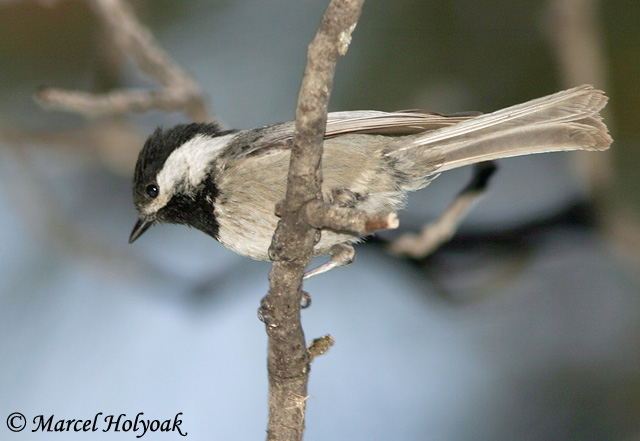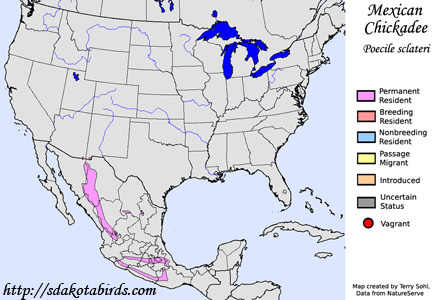| Length: 5 inches | Wingspan: 8.25 inches | Seasonality: Non-resident in South Dakota |
| ID Keys: Grayish overall, lacking the buffy blanks of other Chickadees, large black bib, black cap, white face. | ||
 The
Mexican Chickadee is well named, with a range that covers much of the
mountainous areas of western Mexico. Their range just extends into the
United States in extreme southern Arizona and New Mexico. The Mexican
Chickadee is similarly sized and structured as many other North American
Chickadee species, but can be readily identified by their overall gray
plumage, with a lack of warmer, buffier tones on their flanks, such as found
on many other Chickadee species.
The
Mexican Chickadee is well named, with a range that covers much of the
mountainous areas of western Mexico. Their range just extends into the
United States in extreme southern Arizona and New Mexico. The Mexican
Chickadee is similarly sized and structured as many other North American
Chickadee species, but can be readily identified by their overall gray
plumage, with a lack of warmer, buffier tones on their flanks, such as found
on many other Chickadee species.
Habitat: Found in montane coniferous forest, although they may move into lower elevation mixed or deciduous forests at times, particularly in the winter.
Diet: Feeds on insects and spiders, but may also feed on seeds.
Behavior: Forages by moving actively through vegetative foliage, hopping about, and sometimes hanging upside down from a branch while they feed. They may also sometimes hover while they glean insects from foliage.
Nesting: The nest of a Mexican Chickadee is in a tree cavity, with the birds excavating their own cavity or enlarging an existing natural cavity. They may also modify an old woodpecker hole, or may use nest boxes. The nesting cavity is lined with moss and strips of soft bark. The female lays between 5 and 8 eggs, and she alone incubates them. When the eggs hatch, the female initially tends to the young while the male feeds the family, but the female also soon leaves the nest site and begins to gather food.
Song: The song of a Mexican Chickadee is a series of multiple short phrases.
Migration: Considered a permanent resident throughout most of its normal range. Some birds that summer at higher elevations likely move to lower elevations for the winter.
Interactive eBird Map: Click here for an interactive eBird map of Mexican Chickadee sightings
Similar Species: Similar in appearance to several other Chickadee species, but the geographic ranges of most species do not overlap with the Mexican Chickadee. The only species with any possible overlap in range is the Mountain Chickadee.
Feeders: Will attend feeders for various seeds and suet.
Conservation Status: Populations may be in decline, but they are still found over a relatively wide geographic area, and are common in parts of their range. The IUCN lists the Mexican Chickadee as a species of "Least Concern".
Further Information: 1) New Mexico Partners in Flight - Mexican Chickadee
2) Audubon Guide - Mexican Chickadee
3) Whatbird - Mexican Chickadee
Photo Information: Photo taken by Marcel Holyoak - May 29th, 2005 - Southeast Arizona - Photo licensed under Creative Commons Attribution NonCommercial NoDerivs 2.0 Generic License.
| Click below for a higher-resolution map |
 |
| South Dakota Status: Non-resident in South Dakota |
Additional Mexican Chickadee Photos (Coming soon!)
